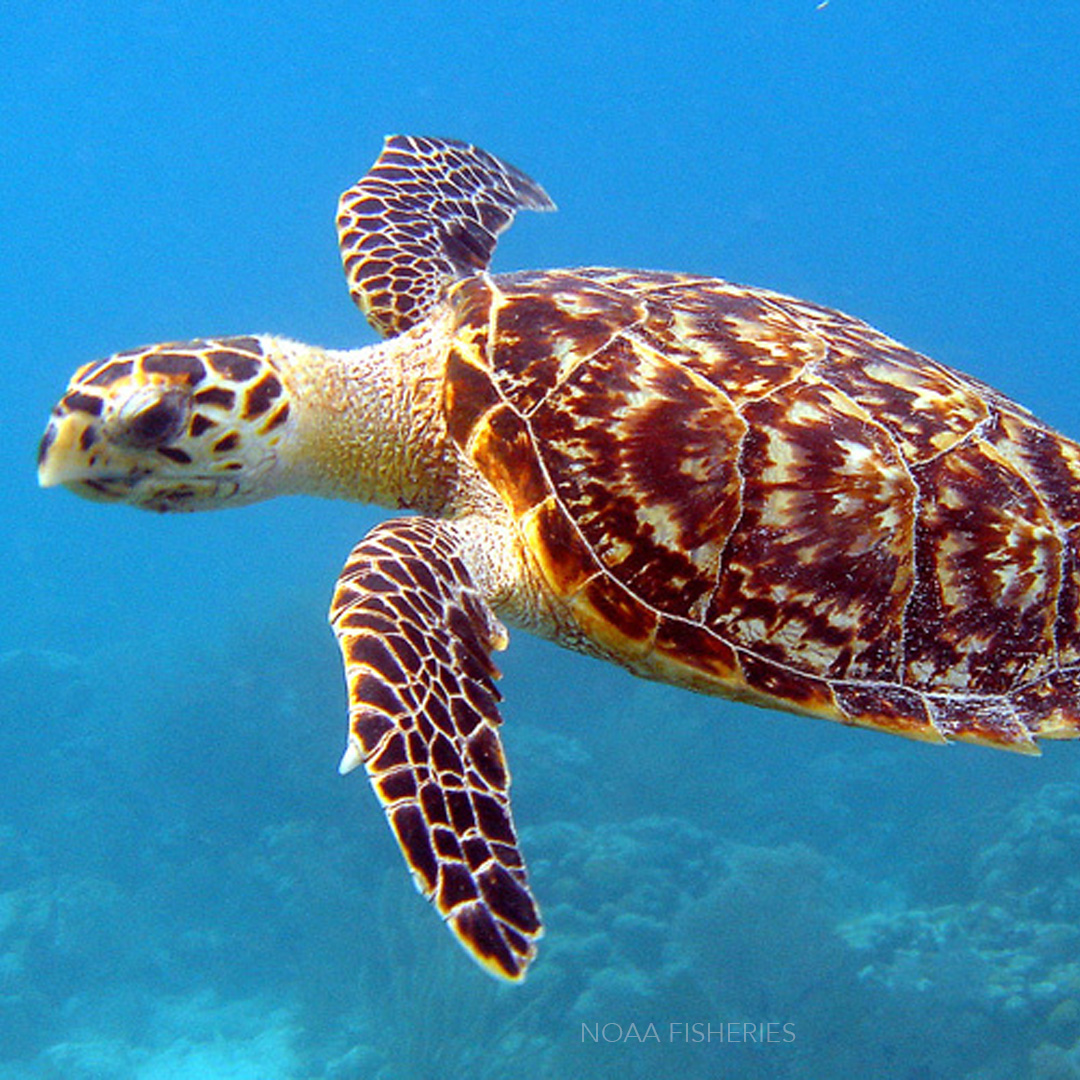Species we study
Sharks are vital to healthy oceans, yet species like the white shark remain poorly understood. OCEARCH fills these knowledge gaps by tagging and studying sharks and other marine species, using our expeditions, open-source Global Shark Tracker™, and global scientific collaborations to reduce extinction risk and drive ocean conservation.
ONE SHARK. GLOBAL IMPACT.
Each animal tagged, sampled, studied, and released fuels discoveries in up to 25 projects worldwide.
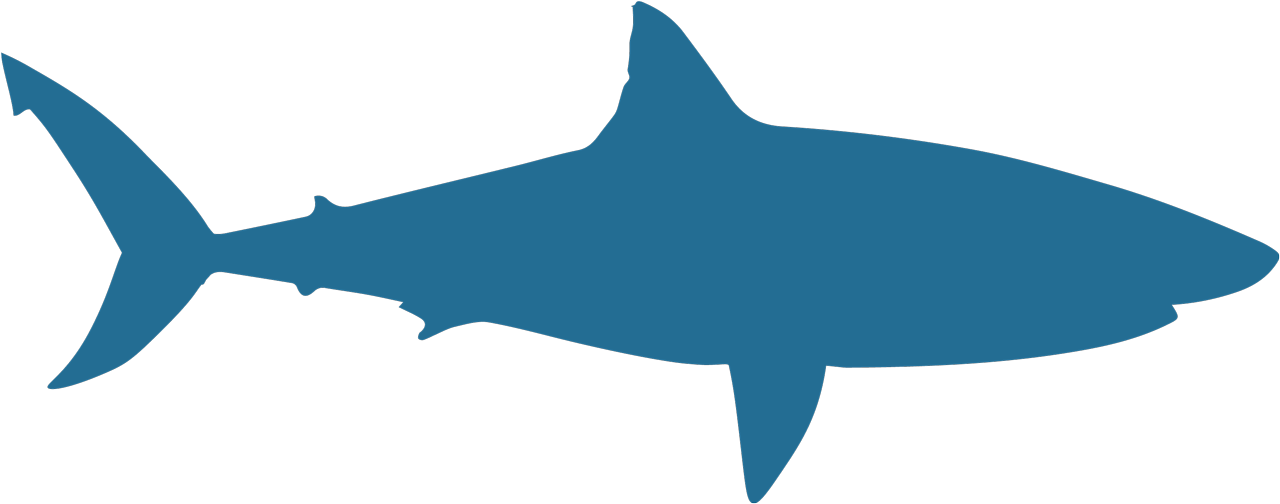
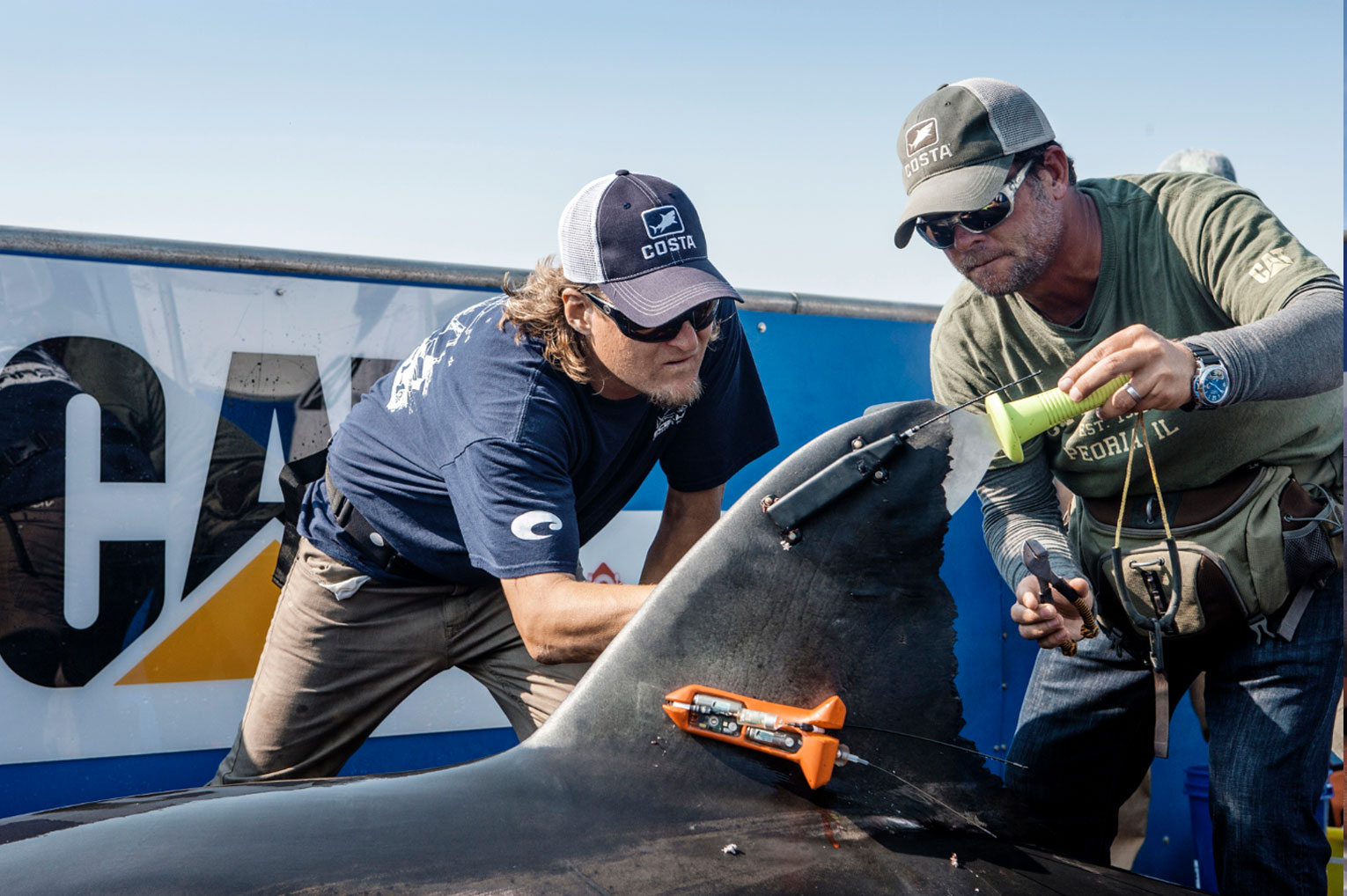
Small sound-emitting devices that allow for receiver-dependent tracking of sharks in multiple dimensions.
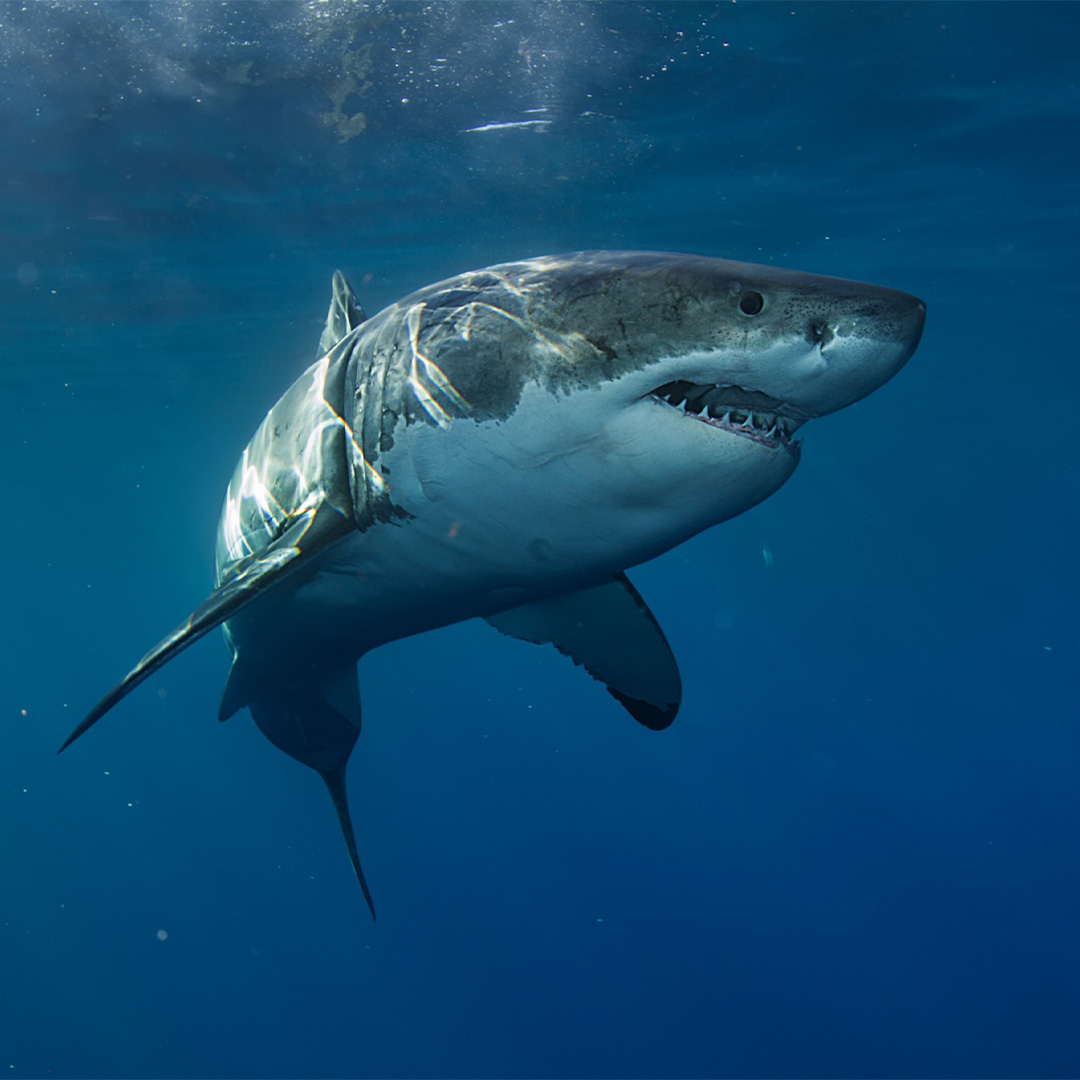
WHITE SHARK
(Carcharodon carcharias)
Known for their power and speed, white sharks are one of the most iconic ocean predators. Females can reach sizes of up to 20 feet and weights of more than 5,000 lbs.
- Largest predatory fish in the ocean.
- The name comes from the shark’s white underside (belly) as their skin is gray to brown when viewed from the top.
- Pups are 4.0 to 5.0 feet in length at birth and weigh from 45 to 70 lbs.
- They grow slowly and are late to mature, with males maturing at about 26 years of age and females at approximately age 33.
- Average female length is 15-16 feet and average male length is 11-13 feet.
- Maximum age is unknown but estimates range from 30 to 70 years.
- Have a diverse opportunistic diet consisting of fish, sharks, invertebrates, and marine mammals.
- The white shark is regionally endothermic (partially warm-blooded) and can maintain its internal body temperature above that of the surrounding water – this enables the white shark to be a more active predator in colder waters.
- Known to breach the water while hunting, especially in South Africa.
- A highly migratory species that travels thousands of miles yearly.
- Occurs in nearshore coastal waters and offshore pelagic waters preferring temperatures between 50 and 80 degrees F.
- Can swim at speeds up to 35 mph.
- They have about 300 serrated teeth arranged in 5 to 7 rows in each jaw.
- Found across all oceans except polar regions.
- Serve as top predators, keeping ocean ecosystems balanced.
- Are considered globally Vulnerable by the IUCN Red List of Threatened Species.
TIGER SHARK
(Galeocerdo cuvier)
Tiger sharks are known for their diverse diet and distinct tiger-like stripes, which fade as they mature.
- A large shark with a broad bluntly rounded snout. They are gray from above with vertical black to dark gray bars and spots with a white belly.
- Often referred to as the “garbage cans of the sea” for their varied diet which includes fish, other sharks, sea turtles, sea snakes, marine iguanas, seabirds, marine mammals, jellyfish and sometimes trash.
- Have sharp, saw-edged teeth ideal for cutting through tough prey.
- Can grow up to 18 feet long or more.
- Born as part of large litters of pups that can range from 10 to 83, but average of 26 to 33.
- Known to migrate long distances.
- Inhabits tropical and temperate waters worldwide.
- .
- Excellent night hunters.
- Known for their powerful jaws and biting force.
- Typically solitary but will gather in feeding areas.
- Are considered globally Near Threatened by the IUCN Red List of Threatened Species
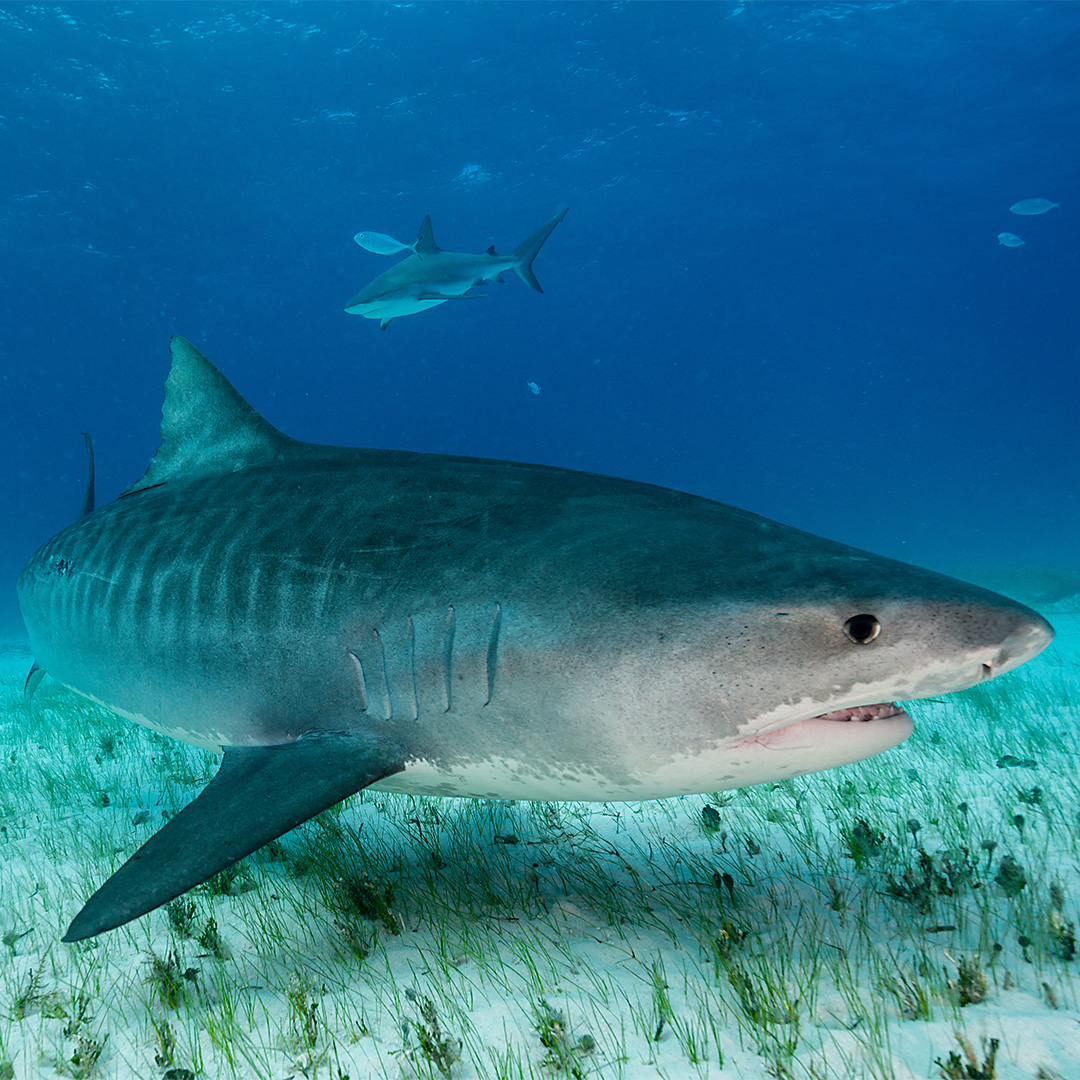
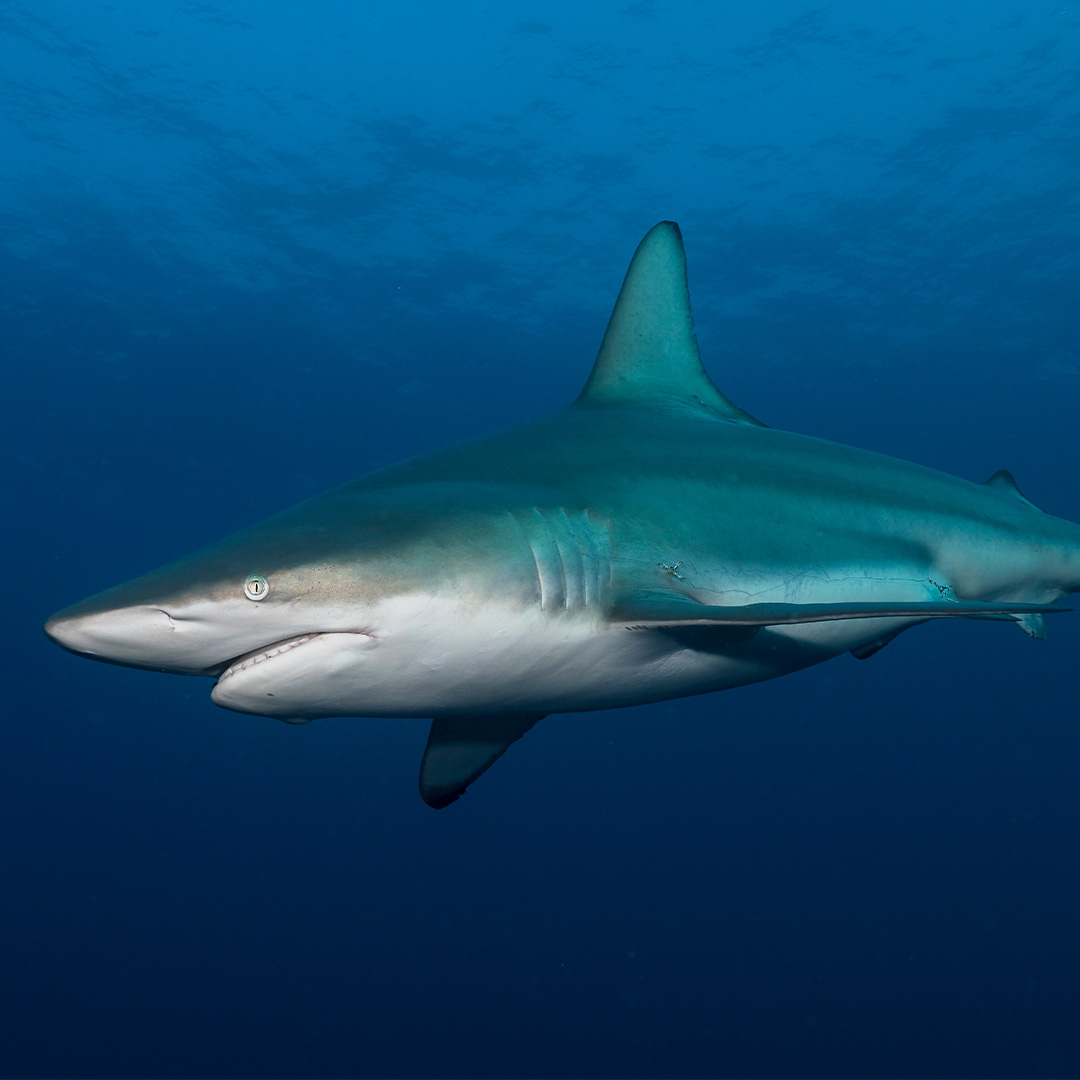
BLACKTIP SHARK
(Carcharhinus limbatus)
Named for the distinctive black tips on their pectoral, second dorsal and caudal fins, blacktip sharks are fast and agile hunters.
- Known to leap out of the water during feeding.
- Found in tropical and subtropical seas often in close inshore waters.
- Average length is 5 feet but can grow to up to 8 feet in length.
- Have a streamlined body for fast swimming.
- Often spotted near coral reefs and estuaries.
- Black-tipped fins are more visible in juveniles.
- Can form large groups during migrations.
- Feed on a variety of fish and invertebrates.
- Commonly seen along the U.S. Atlantic coast but are present worldwide in tropical and subtropical seas.
- Play an essential role in balancing coastal ecosystems.
- Are considered globally Vulnerable by the IUCN Red List of Threatened Species.
SHORTFIN MAKO SHARK
(Isurus oxyrinchus)
The fastest shark in the ocean, capable of reaching burst speeds of up to 45 mph.
- Known for their impressive speed and agility.
- Can leap high out of the water.
- Have a lifespan estimated to be 28-35 years.
- Can be up to about 14 feet in length but average size is 6-7 feet with females maturing at larger sizes than males.
- Feed on fish including billfish and tuna, squid, and other sharks.
- Found globally in temperate and tropical waters.
- Known for their pointed snout, streamlined body and crescent-shaped tail.
- Can travel long distances across the open ocean.
- Have highly acute vision for hunting.
- Recognized for their blue coloration.
- Considered one of the most athletic shark species.
- Are considered globally Endangered by the IUCN Red List of Threatened Species after being heavily fished for their meat and fins.
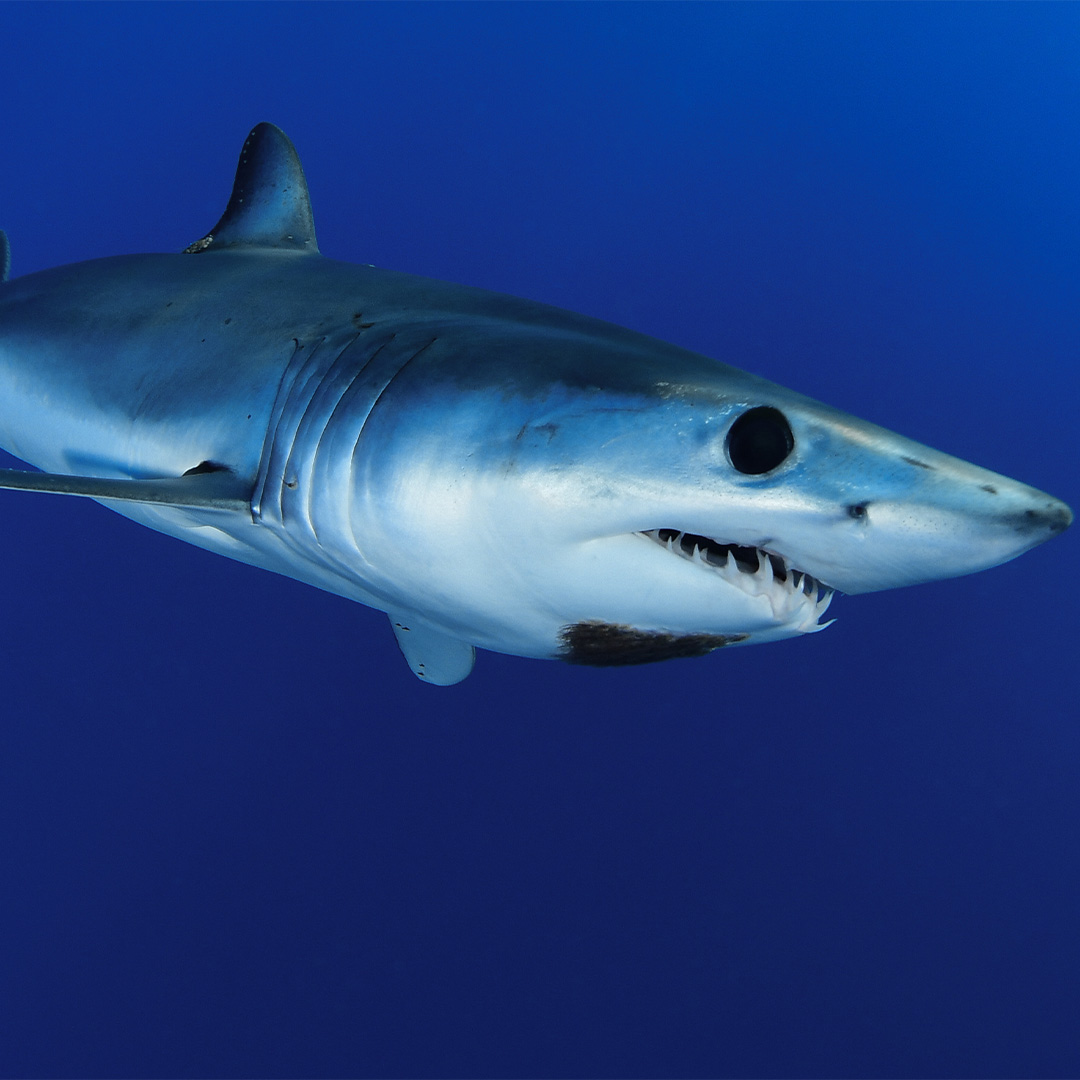
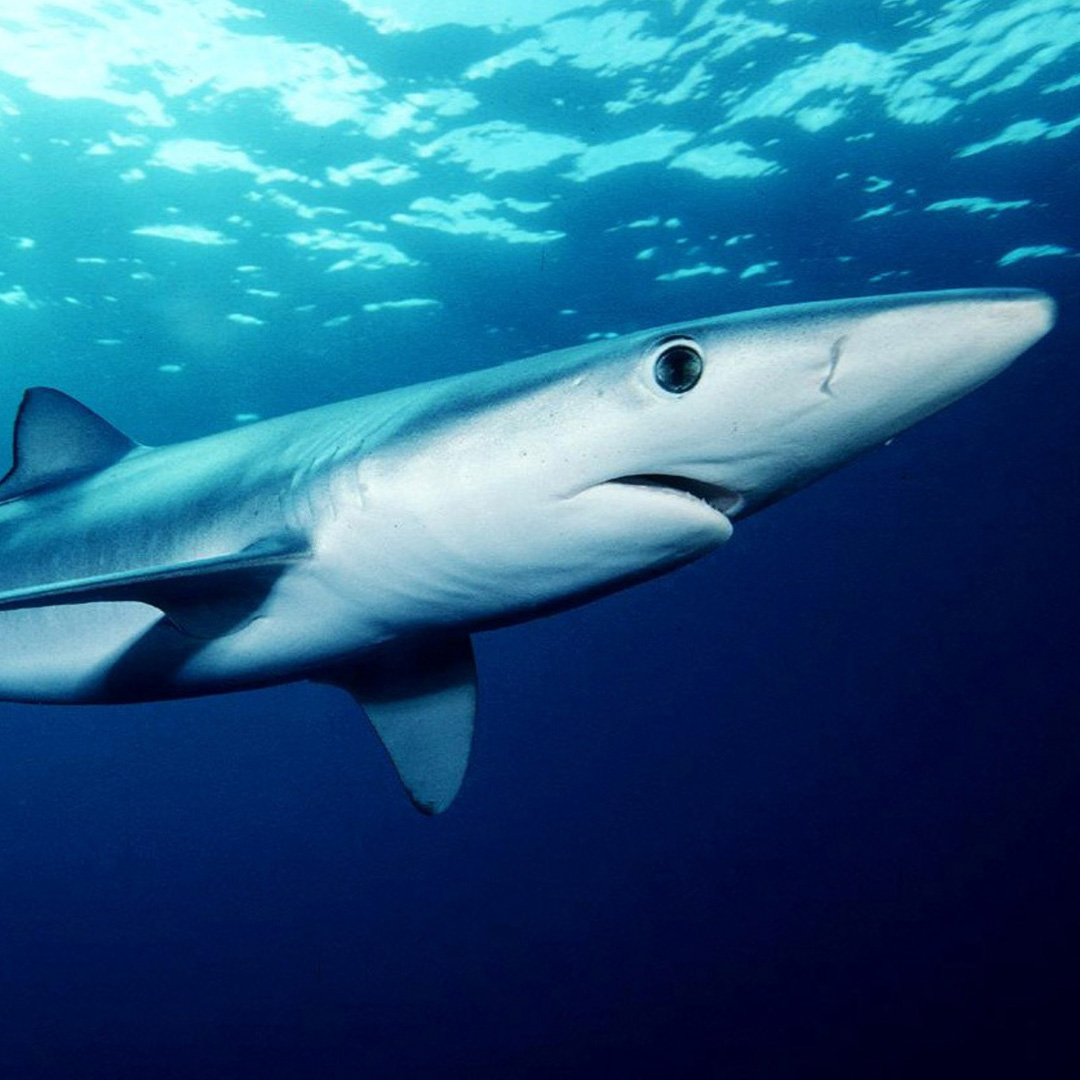
BLUE SHARK
(Prionace glauca)
Blue sharks are easily recognizable by their slender bodies and vibrant blue color.
- Known for their deep blue color and sleek shape.
- Can measure up to at least 13 feet long but are typically around 10 feet long as adults.
- Inhabit all major oceans and is possibly the most wide-ranging shark worldwide.
- A highly migratory species that can travel long distances.
- Known to hunt in schools when food is abundant.
- Feed mainly on squid and small fish.
- Have large litters, usually 25-35, but sometimes up to 135 pups.
- Can live up to 20 years in the wild.
- Known for their graceful swimming.
- The most widely caught and traded shark worldwide for their fins.
- Are considered globally Near Threatened by the IUCN Red List of Threatened Species and Critically Endangered in the Mediterranean Sea.
SCALLOPED HAMMERHEAD
(Sphyrna lewini)
The species has a wide, flattened, hammer-shaped head (cephalofoil) with a central notch on the front edge, giving it a “scalloped” appearance.
- Adults typically range from 8 to 11 feet in length, with some individuals reaching up to 14 feet.
- Found in warm temperate and tropical waters worldwide, typically in coastal regions, continental shelves, and along seamounts.
- In some parts of their range, scalloped hammerheads often form large, highly structured schools during the day, especially females.
- The wide spacing of the eyes on the hammer provides a broad visual field and enhanced depth perception.
- The cephalofoil is packed with ampullae of Lorenzini (electroreceptors), allowing the shark to detect prey (esp. buried) more effectively.
- They are opportunistic predators that feed on bony fishes, cephalopods (like squid and octopus), rays, and smaller sharks.
- Heavily impacted by non-target fisheries, this species is listed as Critically Endangered by the IUCN Red List of Threatened Species.
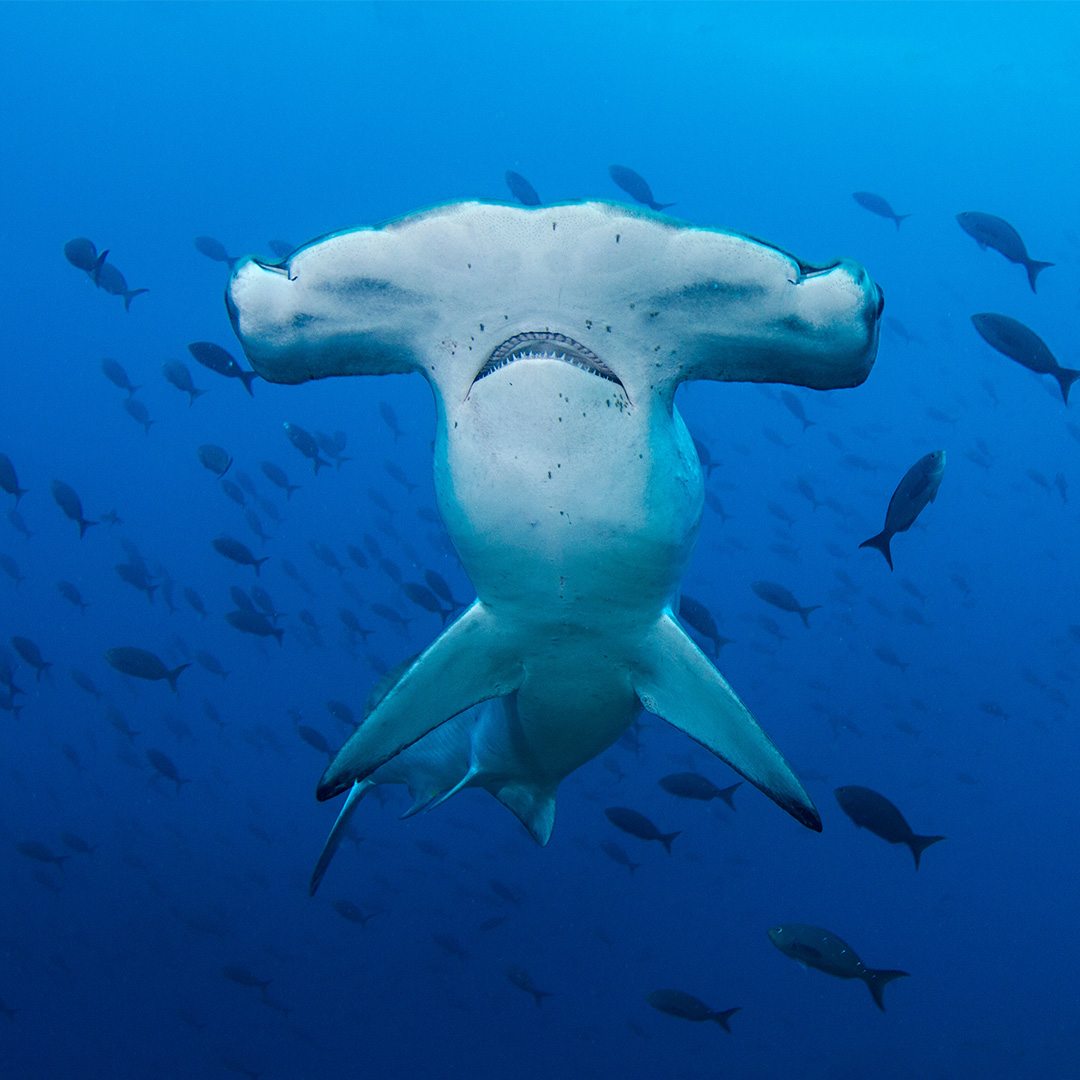
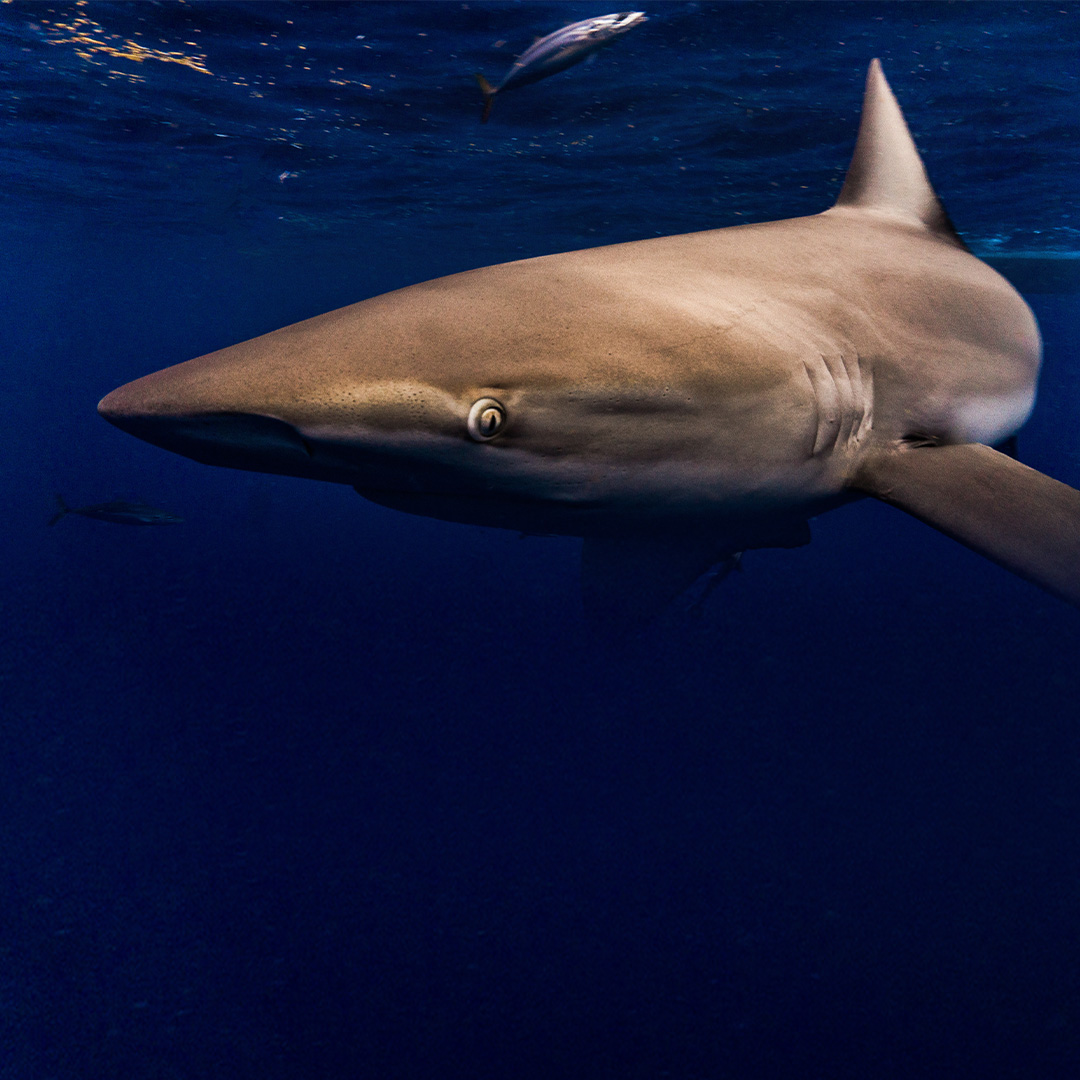
DUSKY SHARK
(Carcharhinus obscurus)
One of the largest requiem sharks, this species has been heavily impacted by overfishing due to slow growth, late maturity, and low reproductive output.
Grey-brown to bluish-gray on top with a white underside; sometimes with faint dusky fin tips, especially the juveniles.
Adults typically 10-11.5 feet in length but can reach nearly 14 feet and 820 lbs.
Has a fusiform body, moderately rounded snout, and a prominent interdorsal ridge between the first and second dorsal fins.
Found in warm-temperate and tropical coastal waters worldwide, often on continental shelves, slopes, and sometimes offshore to depths of at least 1,640 feet.
A highly migratory species that undertakes long-distance seasonal movements, with juveniles using coastal nurseries and adults often moving well offshore.
Generalist predator feeding on bony fishes, cephalopods, rays, and other sharks, including smaller dusky sharks.
Classified as Endangered by the IUCN Red List of Threatened Species.
BULL SHARK
(Carcharhinus leucas)
Bull sharks are known for their ability to thrive in both saltwater and freshwater environments.
- Found in warm-temperate and tropical coastal regions worldwide.
- Can tolerate lower salinity water, are often found in lagoons, bays, and estuaries.
- Pups are born in estuaries and freshwater rivers.
- Known to swim far up rivers such as the Amazon, Zambezi, and Mississippi.
- Special kidney and rectal gland adaptations allow them to regulate salt and survive long-term in freshwater environments.
- Recognizable by their stocky, build, blunt snout and relatively small eyes.
- One of the most common species involved in human interactions and bites.
- They can grow to at least 11 feet in length but reportedly can reach 14 feet.
- Have powerful jaws and a diverse diet including bony fishes, rays, other sharks, invertebrates, sea turtles, dolphins and seabirds.
- They are ecologically important predators in coastal ecosystems.
- Are considered globally Vulnerable by the IUCN Red List of Threatened Species.
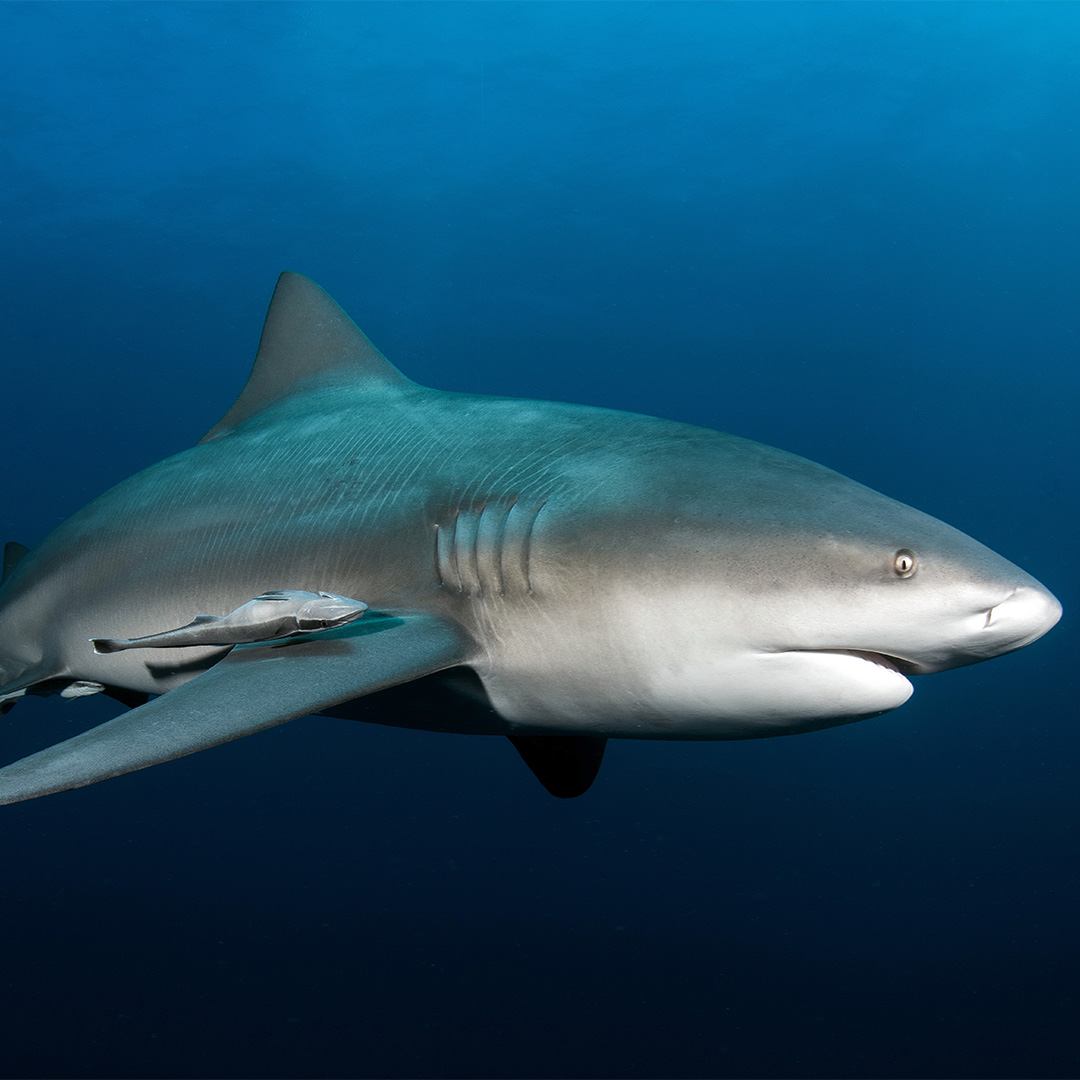
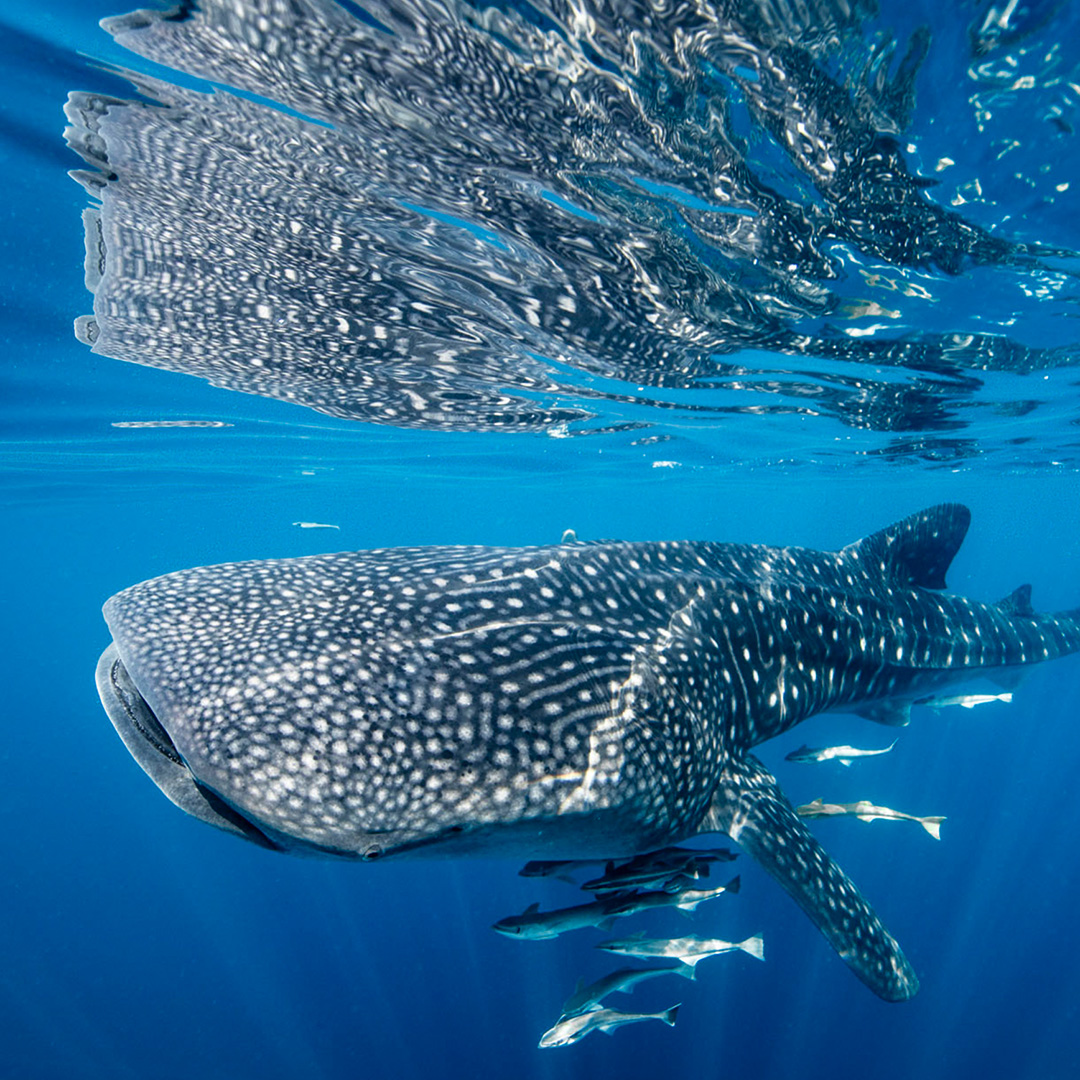
WHALE SHARK
(Rhincodon typus)
The largest fish in the ocean, whale sharks are gentle giants that feed primarily on plankton and small fish.
- Can grow up to 40 feet or more in length.
- Known for their distinct checkerboard or spotted pattern on gray to blue skin; each whale shark has a distinct pattern, like a fingerprint, which scientists use for individual identification.
- Whale sharks have specialized filtering pads located in their pharynx which they use to strain plankton, fish eggs, and other small organisms from the water.
- May gather in large groups (several hundred animals) at annual, seasonal and lunar fish and invertebrate spawning events to feed.
- Found in tropical and warm temperate seas except for the Mediterranean.
- Known to migrate thousands of miles.
- Have a lifespan of up to 70 years.
- Females produce eggs that hatch inside their bodies, giving birth to live pups that are born at 1.5 to 2.0 feet in length.
- The only recorded pregnant female studied to date was carrying 300 pups and eggs.
- Pose no threat to humans.
- Known to interact peacefully with divers and snorkelers.
- Are considered globally Endangered by the IUCN Red List of Threatened Species.
GREAT HAMMERHEAD SHARK
(Sphyrna mokarran)
The largest species of hammerhead, great hammerheads are easily recognized by their distinctively wide head.
- Known for their wide, flat hammer-shaped head (cephalofoil) and unusually tall and curved first dorsal fin.
- Can reach up to at least 20 feet in length.
- Prefers warm temperate and tropical seas worldwide.
- Have wide ranging habitat use from nearshore to well offshore (coastal-pelagic and semi-oceanic).
- Favors continental and insular coral reefs but often associated in inlets and the mouths of bays.
- Feeds on fish (groupers and marine catfishes) with a preference for stingrays as well as other sharks and squid.
- Asolitary hunter, often patrolling reefs and sandy flats in search of prey.
- Have a lifespan of about 20-30 years.
- Use their head to pin down stingrays.
- Their conservation status is Critically Endangered by the IUCN Red List of Threatened Species.
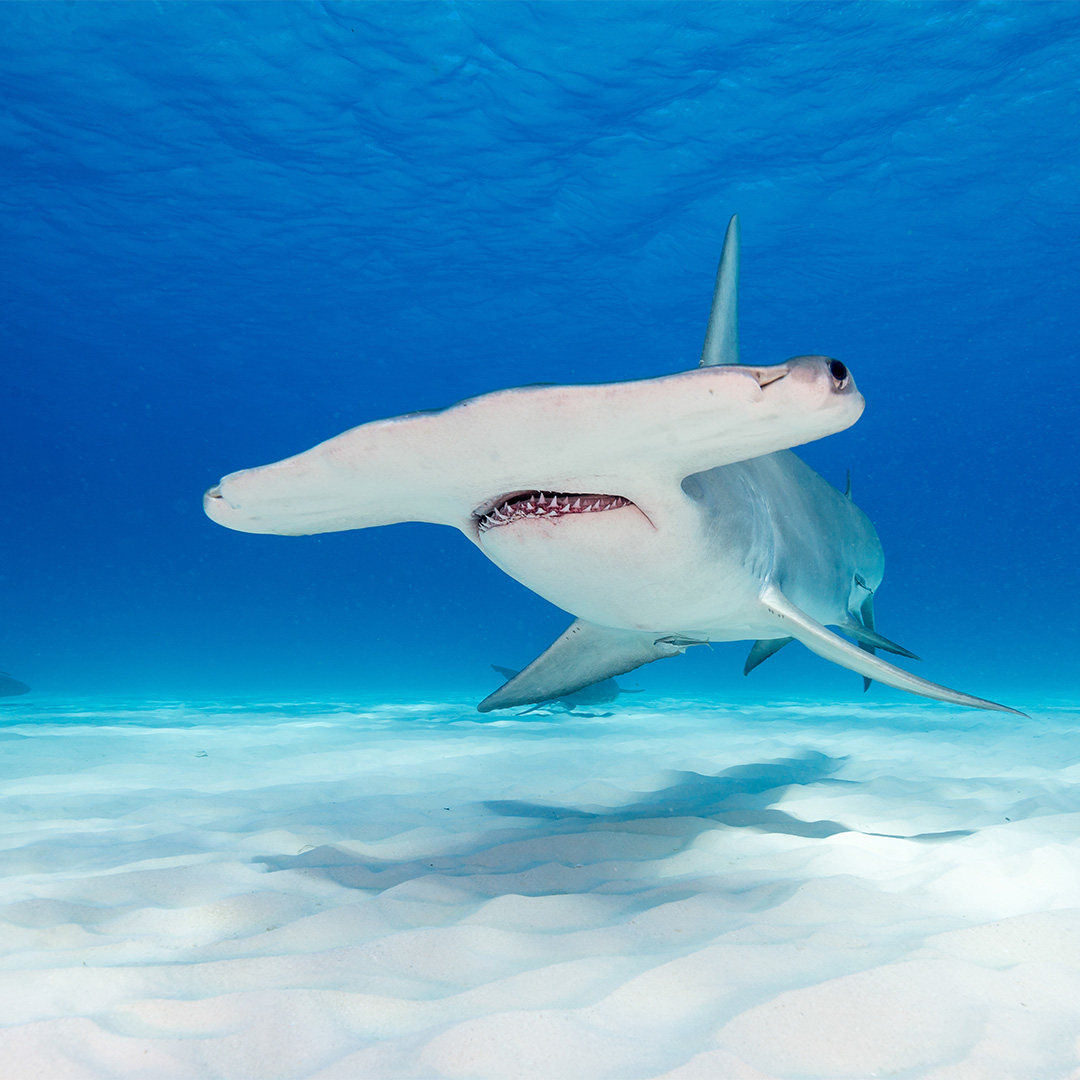
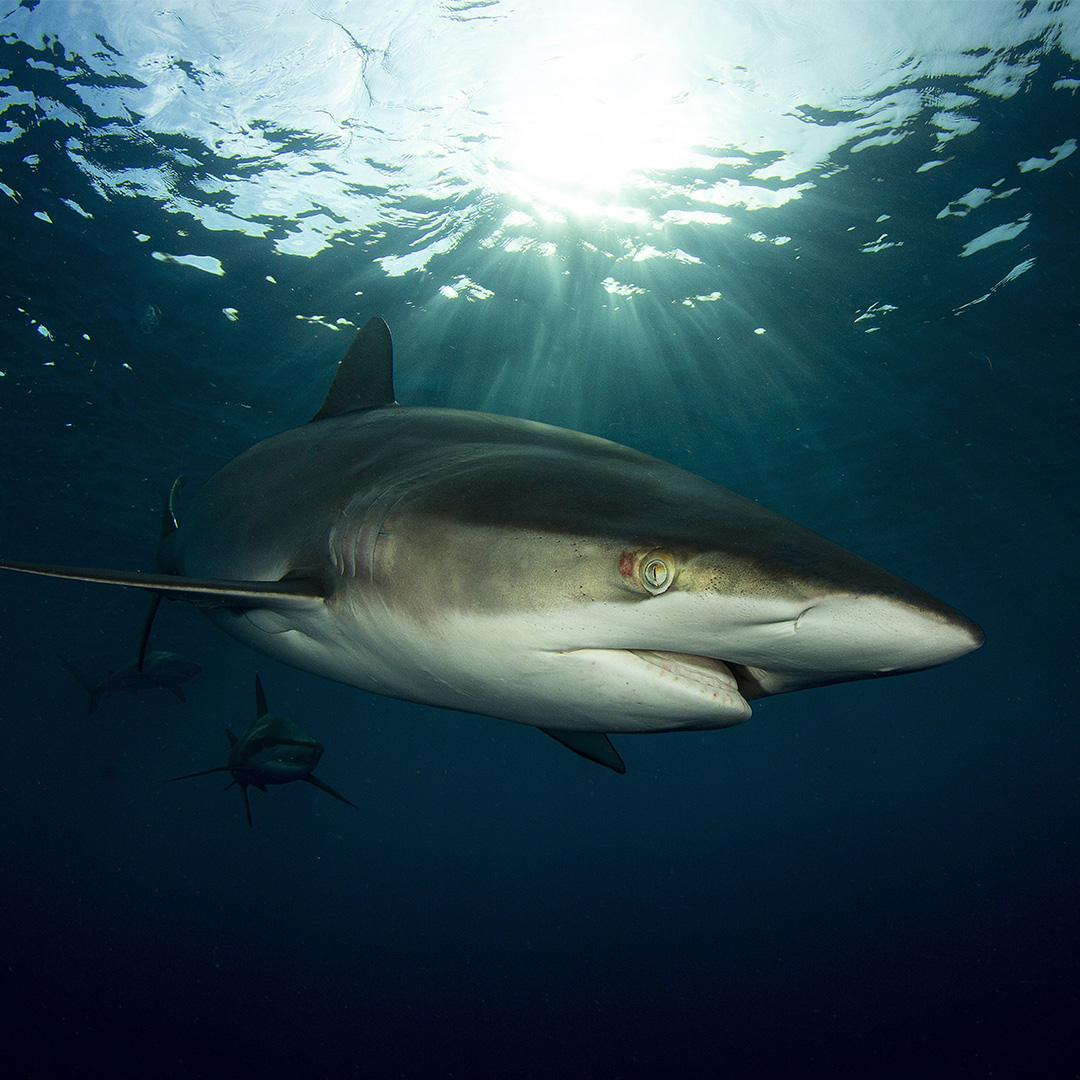
SILKY SHARK
(Carcharhinus falciformis)
A relatively abundant and wide-ranging species of large pelagic shark.
- Have a long, slender, and streamlined body with a smooth, silky skin texture that gives them their common name.
- Can reach a maximum length of about 11 feet, though most individuals are typically 6–9 feet long.
- First dorsal fin is relatively small and starts behind the rear edge of the pectoral fins, which helps distinguish them from similar-looking sharks.
- Typically bronze to dark gray on top with a white underside.
- Found in warm, tropical, and subtropical oceans worldwide, usually offshore in deep waters near the edges of continental shelves.
- Opportunistic predators feeding mainly on schooling fish (like tuna and mackerel) and cephalopods.
- Listed as Vulnerable by the IUCN Red List of Threatened Species due to high bycatch rates in tuna and longline fisheries, and demand for their fins.
AMERICAN ALLIGATOR
(Alligator mississippiensis)
A native of the southeastern United States, American alligators thrive in freshwater environments.
- Found in freshwater lakes, rivers, and swamps.
- Broad, muscular body with a wide, rounded snout (distinguishing them from crocodiles, which have narrower, V-shaped snouts).
- Known for their powerful bite.
- Male alligators can grow up to 15 feet long. Females are smaller measuring up to 10 feet.
- Opportunistic carnivores that eat fish, birds, reptiles, amphibians, and mammals; they are also known to scavenge.
- The temperature of an alligator nest determines the sex of the offspring.
- Unlike most reptiles, female alligators are known for their maternal care.
- Known to create “gator holes” that support other wildlife.
- Have a lifespan of about 35-50 years in the wild.
- Can run quickly on land for short distances.
- Protected under conservation laws in the U.S.
- Known for their deep, bellowing calls.
- Lay eggs (20-50) in nests made of vegetation and soil.
- Once endangered due to overhunting and habitat loss, the species has recovered under legal protection and is now listed as a species of Least Concern by the IUCN Red List of Threatened Species.
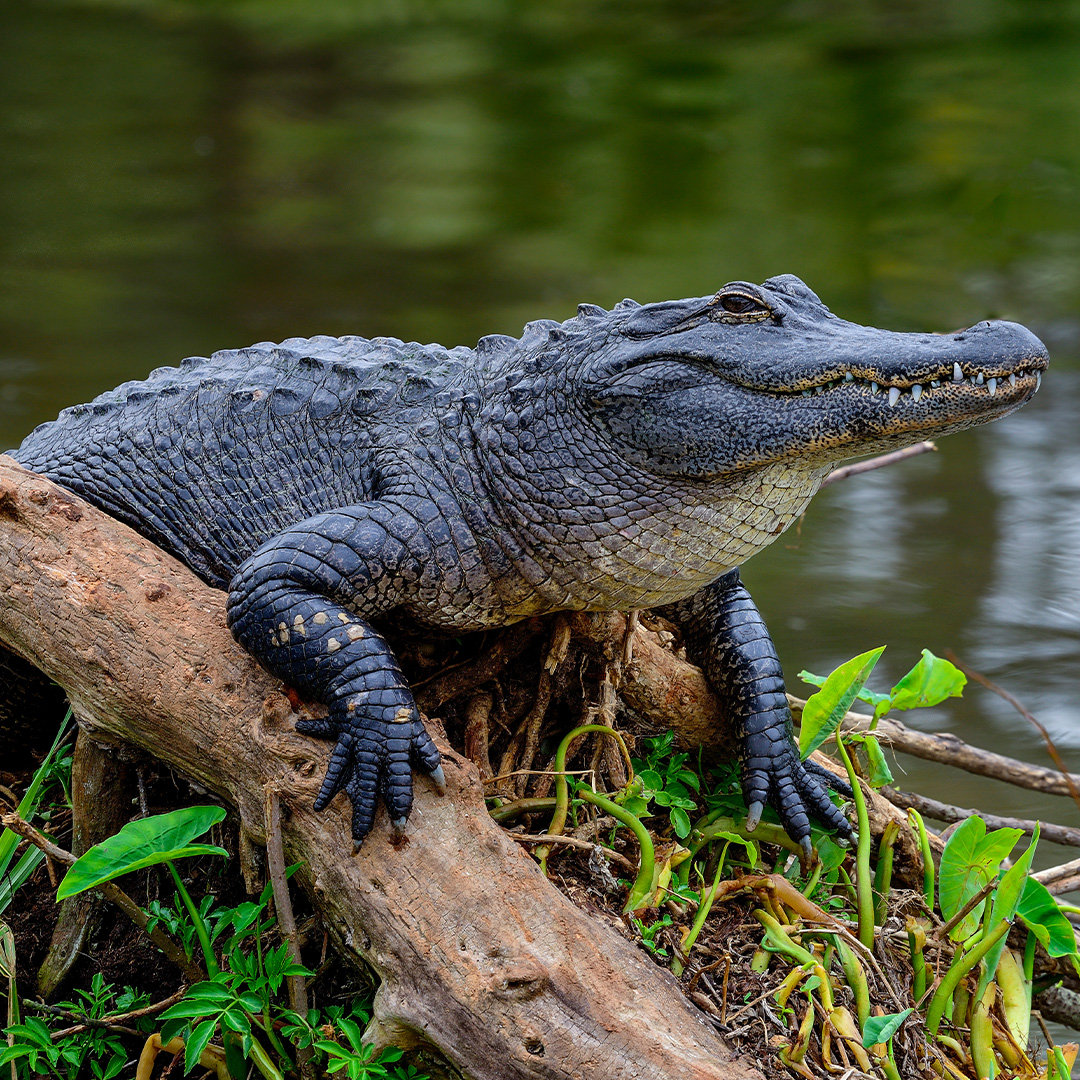

LONG-BEAKED COMMON DOLPHIN
(Delphinus capensis)
As their name suggests, they have a noticeably elongated rostrum (beak) compared to the short-beaked common dolphin.
- Found in warm-temperate and tropical waters, typically in coastal areas and continental shelf zones.
- Have a striking crisscross or “hourglass” pattern on their sides: a light gray to yellow/tan patch forward of the dorsal fin and darker gray toward the back.
- Adults typically reach 6.5–8 ft in length and weigh around 220–330 lbs.
- Tall, sickle-shaped (falcate) dorsal fin, usually dark gray to black, located mid-back.
- Highly social; often found in large pods that can number from dozens to several thousand individuals.
- Opportunistic feeders, primarily eating small schooling fish (anchovies, sardines, mackerel) and squid.
- Listed as a species of Least Concern by the IUCN, but populations face threats from bycatch, habitat degradation, and reduced prey availability.
GUADALUPE FUR SEAL
(Arctocephalus townsendi)
These seals are rare and found mainly on Guadalupe Island, Mexico, known for their thick fur coats.
- Have thick, dark brown to black fur with a lighter, silvery guard-hair sheen; their dense underfur historically made them a target for commercial hunting.
- Breed primarily on Guadalupe Island (Mexico), with a smaller rookery on San Benito Islands; they prefer rocky, remote shores and caves for resting.
- Adult males reach about 6.5 ft in length and weigh 300–350 lbs, while females are smaller, around 4–5 ft and 100–120 lbs.Can dive to over 300 feet for prey and remain submerged for over 10 minutes while searching for prey.
- Opportunistic predators feeding mostly on squid, mackerel, sardines, and other schooling fish.
- Nocturnal foragers that travel far offshore at night to feed, returning to land during the day.
- Typically live about 13-20 years.
- Known for their playful behavior.
- Have excellent underwater vision.
- Once thought extinct due to 19th-century hunting, currently listed as species of Least Concern by the IUCN.
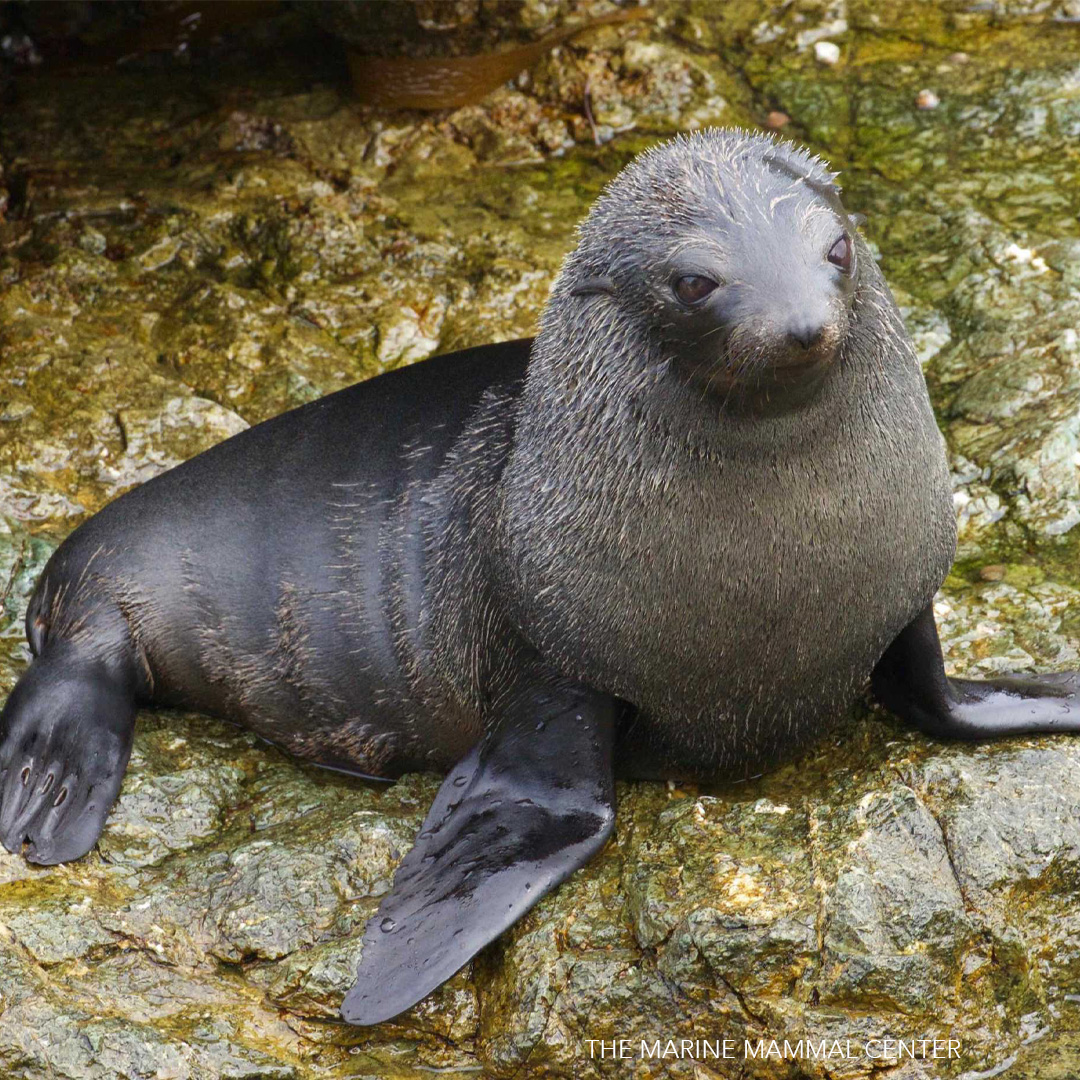
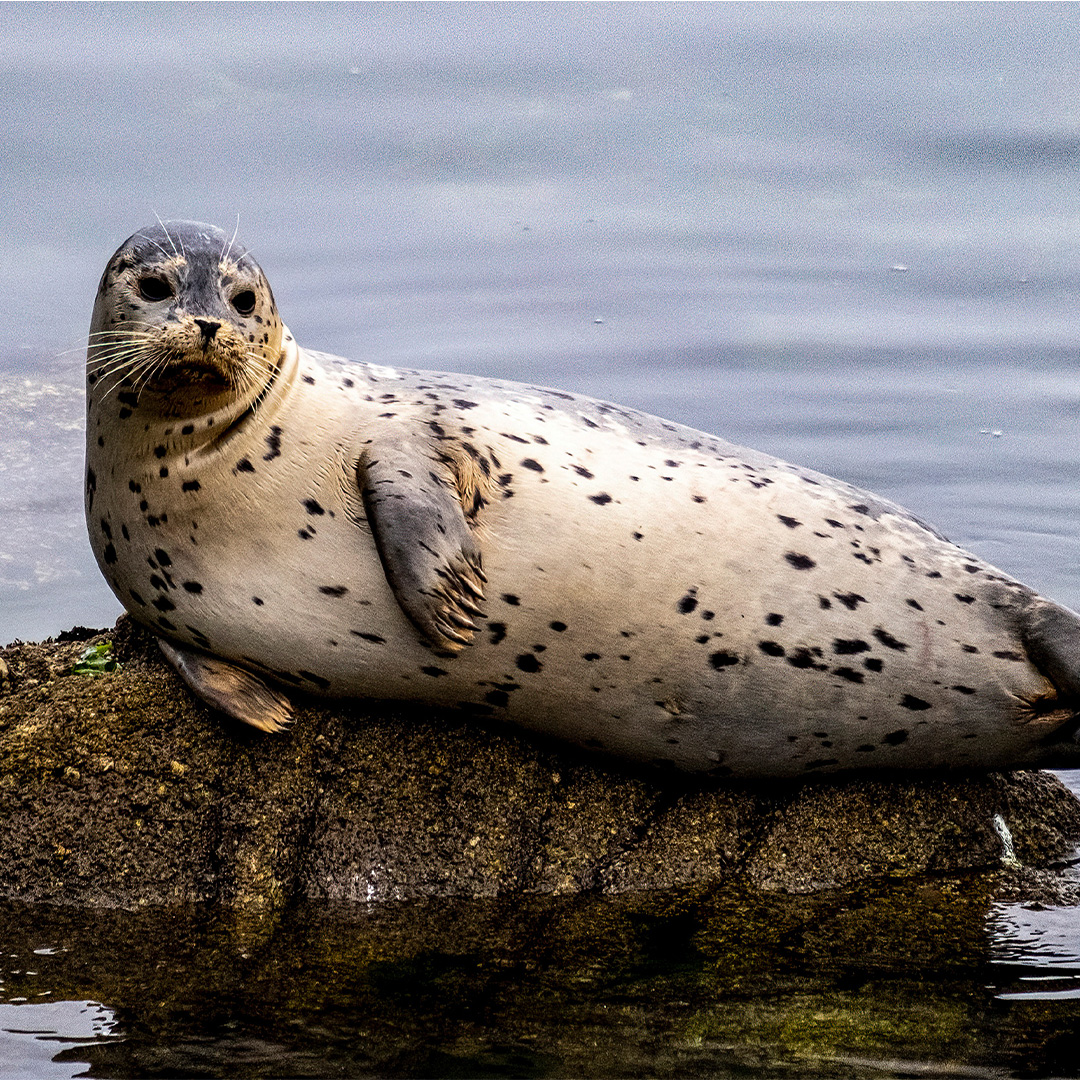
HARBOR SEAL
(Phoca vitulina)
Harbor seals are commonly seen along coastlines and are known for their curious and playful nature.
- Found along coastlines in North America, Europe, and Asia – they are one of the most widespread pinniped species.
- A relatively small seal species, adults measure 5–6 ft in length and weigh 120–375 lbs, with males only slightly larger than females.
- Streamlined, torpedo-like body with a short, rounded head and no external ear flaps (true seal characteristic).
- Opportunistic feeders, consuming a wide variety of fish (herring, cod, flatfish), squid, and crustaceans, depending on local availability.
- Can dive to over 1,500 feet and hold their breath for up to 30 mins.
- Have a thick layer of blubber that insulates them from cold water and also serves as an energy reserve.
- Can live in both saltwater and freshwater.
- Known for their spotted fur coats.
- Each harbor seal has a unique pattern of spots on its coat, much like human fingerprints, and can help researchers identify individuals.
- Have excellent underwater vision.
- Use their whiskers to detect prey.
- Play a crucial role in coastal ecosystems.
- Listed as a species of Least Concern by the IUCN.
BROADBILL SWORDFISH
(Xiphias gladius)
Swordfish are powerful swimmers known for their long, sword-like bills used to slash at prey.
- Known for their long, sword-like bill.
- Grow up to 15 feet in length. Females generally grow larger than males.
- Found in deep, warm ocean waters.
- Among the fastest fish in the ocean – can swim up to 60 mph.
- Feed primarily on fish and squid.
- Known to vertically migrate throughout the day, staying deeper during the day and coming closer to the surface at night to forage.
- Have a lifespan of about 9 years.
- Known to slash at prey with their bill.
- Active hunters, especially at night.
- Play a critical role in marine ecosystems by helping to regulate the populations of prey species.
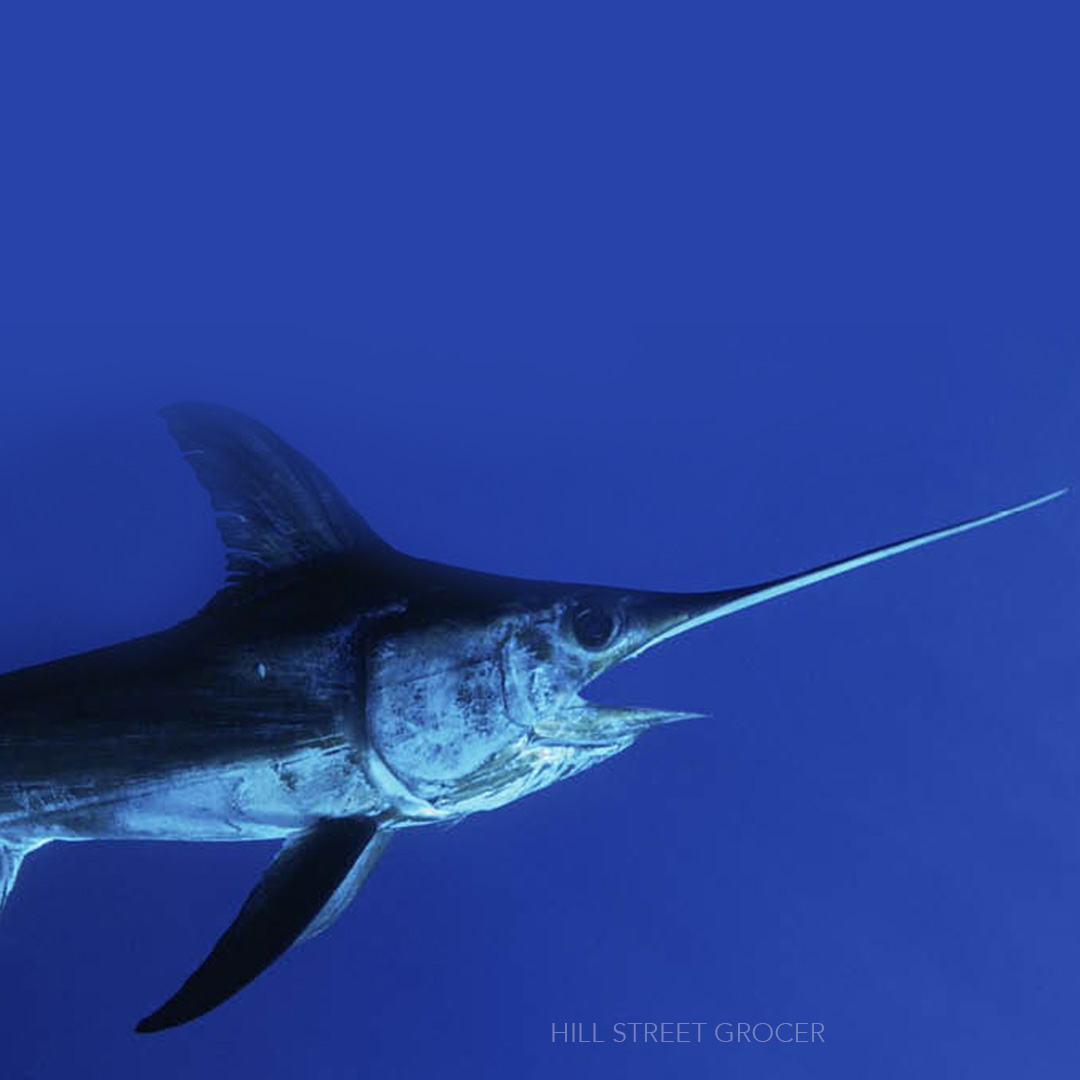
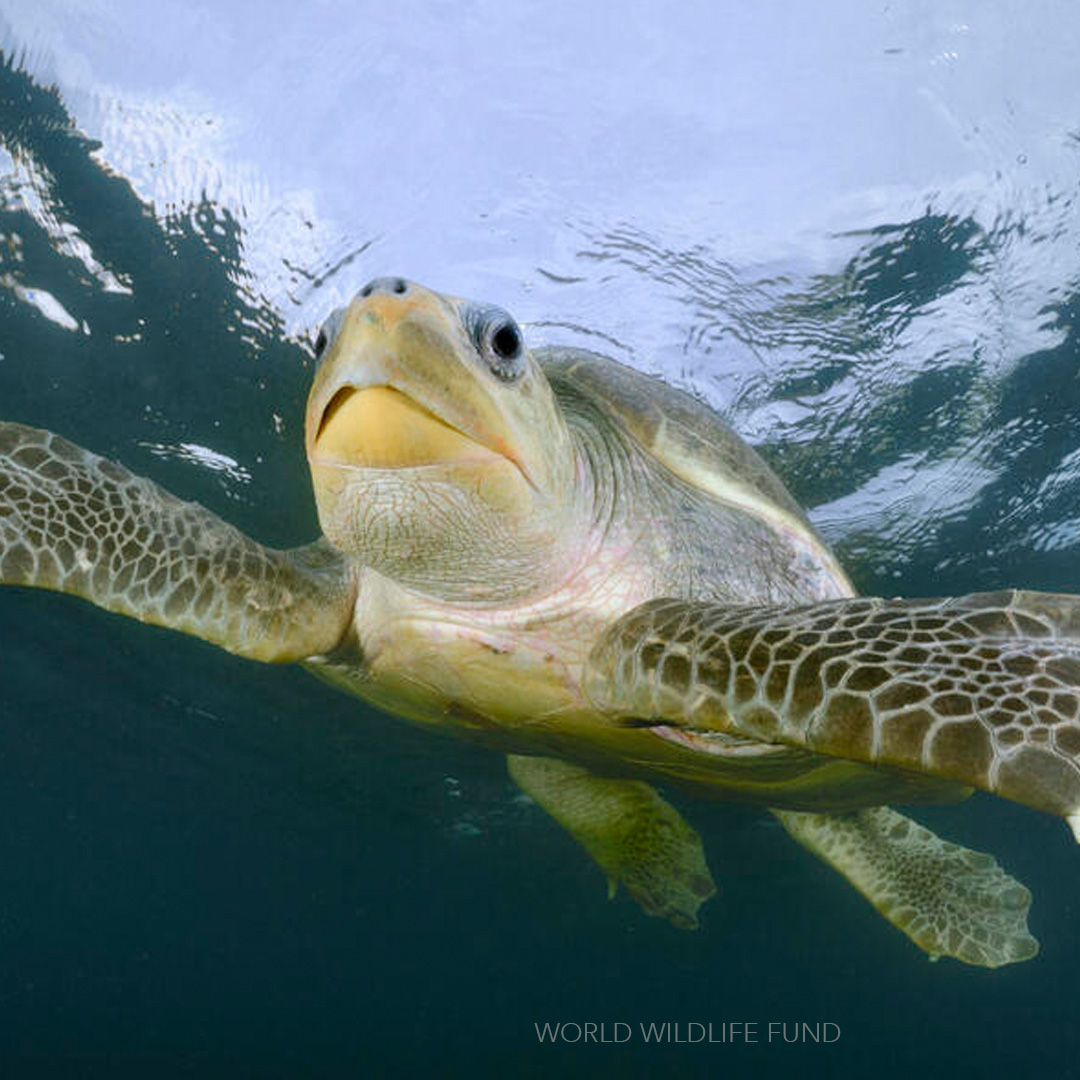
OLIVE RIDLEY TURTLE
(Lepidochelys olivacea)
Known for their mass nesting events called arribadas, these turtles one of the smaller the sea turtle species.
- Their name originated from their heart-shaped olive colored shell.
- One of two species of sea turtle, both genus Lepidochelys, that practice synchronized mass nesting known as Arribadas, which is Spanish for arrival.
- One of the smaller sea turtle species.
- Primarily found in tropical waters of the Pacific, Atlantic and Indian Oceans
- Are omnivorous, feeding on algae, lobster, crabs, tunicates and mollusks.
- Can dive deep, up to 500 feet, to feed on bottom-dwelling invertebrates.
- Their lifespan is unknown but is estimated to be 50 to 60 years in the wild.
- They take up to 14 years to reach maturity.
- Known for their impressive navigation skills.
- Their greatest threats are bycatch (accidental capture) in fishing gear and direct harvest for their meat and eggs.
- Are protected under the Endangered Species Act.
- Their conservation status is globally vulnerable by the IUCN Red List of Threatened Species, but the western North Atlantic population is considered endangered and declining.
LOGGERHEAD SEA TURTLE
(Caretta caretta)
Loggerheads are known for their large heads and powerful jaws, ideal for crushing prey like whelks and conchs.
- Have a heart-shaped red-brown shell.
- Are 2.5 to 3. 5 feet long and weigh between 200 and 350 pounds as adults.
- Known for their large, strong jaws.
- Loggerheads are known to feed on jellyfish, crabs, mollusks, squid, fish eggs, and more. Exact lifespan is unknown but they are estimated to live 70-80 years.
- Loggerhead turtles are found worldwide primarily in subtropical and temperate regions of the Atlantic, Pacific, and Indian Oceans, and in the Mediterranean Sea.
- In the Atlantic Ocean, the loggerhead turtle’s range extends from Newfoundland to Argentina.
- In the eastern Pacific, loggerheads have been reported from Alaska to Chile.
- Hatchlings and juveniles spend the first 7 to 15 years of their lives in the open ocean before they migrate to nearshore coastal areas where they forage and continue to grow for several more years
- Adult loggerhead turtles migrate hundreds to thousands of kilometers from their foraging grounds to their nesting beaches.
- Female loggerheads reach maturity at about 35 years of age.
- Female loggerheads mate every 2 to 3 years in coastal waters and return to nest on a beach in the general area where they hatched decades earlier.
- Their primary threats are bycatch in fishing gear, direct harvest for meat and eggs and ocean pollution/marine debris particularly floating plastics.
- Protected by the Endangered Species Act
- Their conservation status globally is Endangered by the IUCN Red List of Threatened Species.
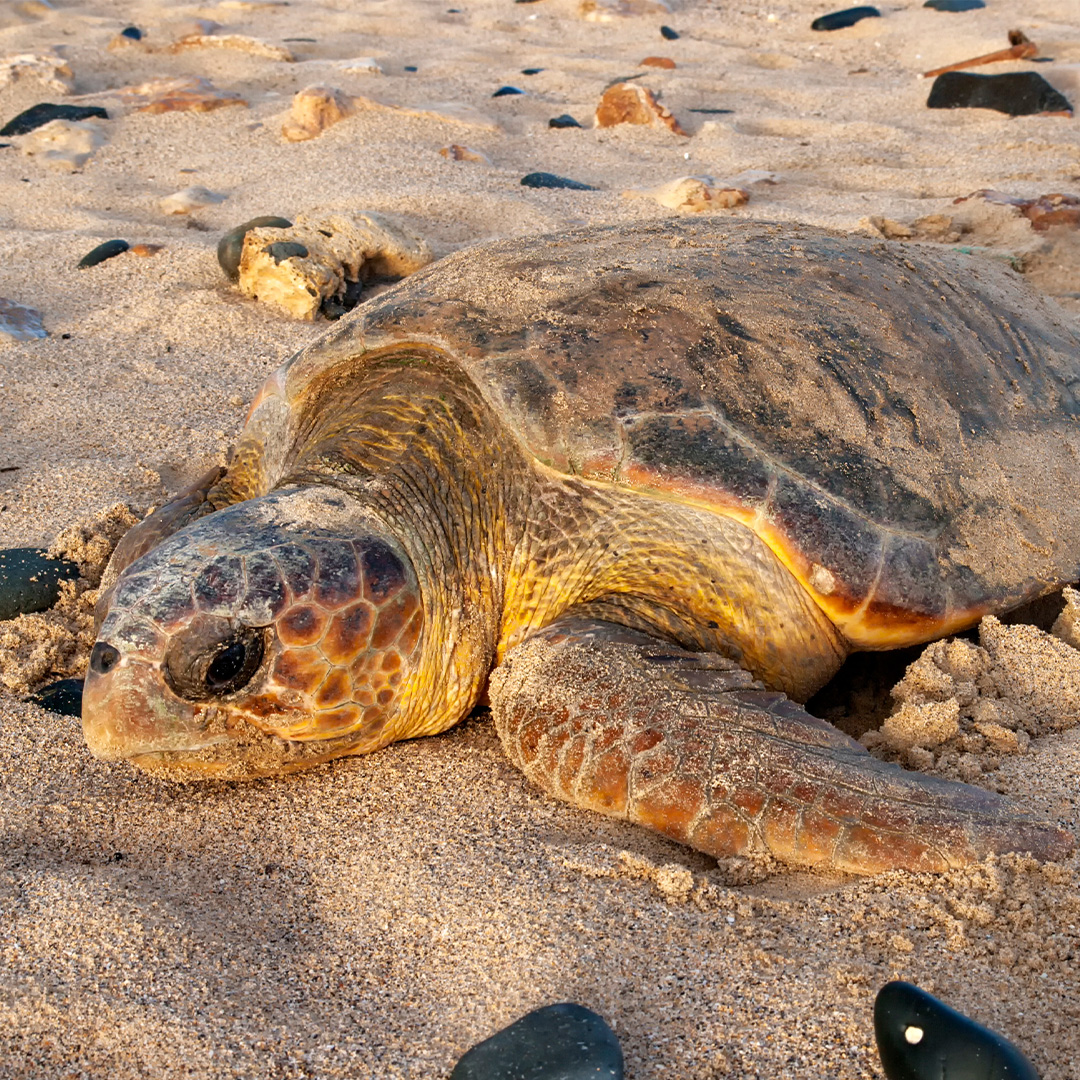
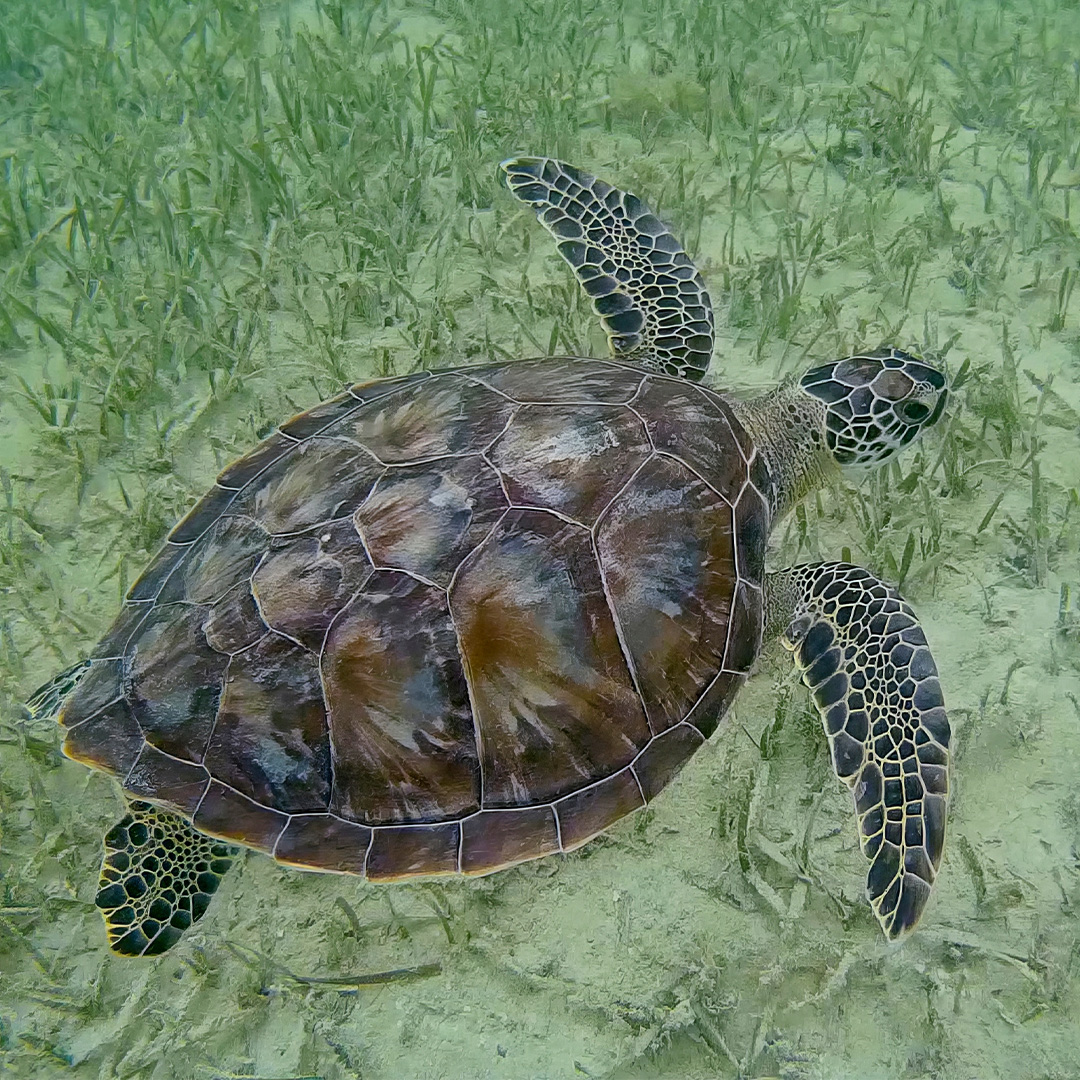
GREEN SEA TURTLE
(Chelonia mydas)
Named for the green color of their body fat, green sea turtles are mostly herbivorous, feeding on seagrass and algae.
- The largest of the hard shelled sea turtles
- Adults are typically 3 to 4 feet long and weigh between 250 and 400 pounds.
- Named for the green color of their body fat, which occurs due to their herbivorous diet.
- They are the only primarily herbivorous sea turtle, feeding on seagrass and algae.
- Green turtles are found worldwide primarily in subtropical and temperate regions of the Atlantic, Pacific, and Indian Oceans, and in the Mediterranean Sea
- Their lifespan is unknown, but is estimated to be up to 70 years.
- After emerging from the nest, hatchlings swim to offshore areas, where they live for several years in the open ocean.
- Juveniles eventually leave the open ocean habitat and travel to nearshore foraging grounds in shallow coastal habitats, where they mature and spend the rest of their lives.
- Adults migrate every 2 to 5 years from their coastal foraging areas to the waters off the nesting beaches near where they originally hatched.
- Primary threats include bycatch in fishing gear, climate change, direct harvest of turtles for their meat and eggs, disease, loss of habitat and marine pollution/debris.
- Their conservation status globally is Endangered by the IUCN Red List of Threatened Species.
LOGGERHEAD X HAWKSBILL HYBRID
(Caretta caretta x Eretmochelys imbricata)
A unique hybrid of loggerhead and hawksbill sea turtles, blending traits from both species.
- A rare hybrid between loggerhead and hawksbill.
- Occur naturally in the wild at locations where foraging and nesting areas overlap between different sea turtle species.
- Loggerhead and hawksbill feeding habits are different; the hybrids that have been tracked tend to feed with other loggerheads suggesting a similar diet.
- Display physical traits of both parent species but the combination of traits vary and hybrids from the same two species don’t always look alike
- Requires genetic testing to confirm their hybrid status.
- The highest number of sea turtle hybrids occurs off the coast of Brazil and in the southwestern Atlantic
- Studies to date suggest that hybrids are fertile and can breed and produce young.
- Studied to understand hybridization effects.
